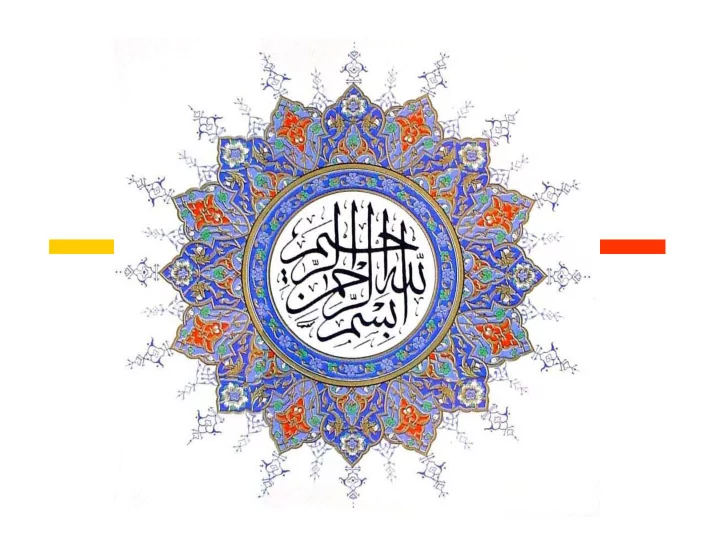

In the name of Allah In the name of Allah the compassionate, the merciful
Digital Video Processing S. Kasaei S. Kasaei Room: CE 307 Department of Computer Engineering Sharif University of Technology E-Mail: skasaei@sharif.edu Web Page: http://sharif.edu/~skasaei http://mehr.sharif.edu/~ipl
Chapter 3 Chapter 3 Video Sampling Video Sampling
Video Sampling Main Concerns 1. What are the necessary sampling frequencies in the spatial & temporal directions? 2. Given an overall sampling rate (i.e., product of the horizontal, vertical, & temporal sampling rates), how do we sample in the 3-D space to obtain the best representation? 3. How can we avoid aliasing? Kasaei 5
Basics of Lattice Theory Λ k � A lattice, , in the real K -D space, ,is R the set of all possible vectors that can be represented as integer-weighted combinations of a set of K linearly independent basis vectors, that is: K ∑ Λ = ∈ = ∀ ∈ k x | x n v , n R Z k k k = k 1 with generating matrix: [ ] [ ] = V v v , , , v L 1 2 k Kasaei 6
Kasaei 7
Basics of Lattice Theory � One can find more than one basis or generating matrix that can generate the same lattice. � Given a lattice, one can find a unit cell such that its translations to all lattice points form a tiling of the entire space. Kasaei 8
Basics of Lattice Theory � Unit cells are of two types: fundamental parallelepiped & Voronoi cell. � There are many fundamental parallelepipeds associated with a lattice (because of the nonuniqueness of the generating matrix). � The volume of the unit cell is unique. Kasaei 9
Basics of Lattice Theory Kasaei 10
Basics of Lattice Theory Determination of Voronoi cell: � Draw a straight line between the origin & each one of the closest nonzero lattice points. � Draw a perpendicular line that is the half way between the 2 points. � This line is the equidistance line between the origin & this lattice point. Kasaei 11
Basics of Lattice Theory Λ * � Given a lattice, its reciprocal lattice, , is defined as a lattice that its basis vector is orthonormal to that of the lattice. [ ] [ ] = − T U T 1 U ( V ) or =I V � The denser the lattice, the sparser its reciprocal. � A generalized Nyquist sampling theory exists, which governs the necessary density & structure of the sampling lattice for a given signal spectrum. Kasaei 12
Sampling over Lattices � To avoid aliasing, the sampling lattice must be designed so that the Voronoi cell of its reciprocal lattice completely cover the signal spectrum. � To minimize the sampling density, it should cover the signal spectrum as tightly as possible. � Most real-world signals are symmetric in frequency contents (spherical support). Kasaei 13
Kasaei 14
Sampling Efficiency d Λ ( ) Sampling density: ρ Λ ( ) Sampling efficiency: Kasaei 15
Sampling of Video Signals � Most motion picture cameras sample a scene in the temporal direction (store a sequence of analog frames on film). � Most TV cameras capture a video sequence by sampling it in temporal & vertical directions (1-D raster scan). � To obtain a full digital video: � Sample analog frames in 2-D. � Sample analog raster scan in 1-D. � Acquire discrete video frames directly using a digital camera, by sampling a scene in 3-D. Kasaei 16
Required Sampling Rates � Governed factors: � Frequency content of the underlying signal. � Visual thresholds in terms of the spatial & temporal cut-off frequencies. � Capture & display device characteristics. � Affordable processing, storage, & transmission costs. Kasaei 17
Kasaei 18
Sampling Video in 2-D 1. The same 2-D sampling density. 2. The same 2-D nearest aliasing. 3. Different nearest aliasing along the temporal frequency axis (less flickering for interlaced). 4. Different mixed aliases (the nearest off- axis alias component). 5. For a signal with isotropic spectral support, the interlaced scan is more Kasaei 19 efficient.
Kasaei 20
Sampling of Video Signals Kasaei 21
Filtering Operations � How practical cameras & display devices accomplish the required prefiltering & reconstruction filters in a crude way. � How the HVS partially accomplishes the required interpolation task. � Camera aperture consists of: � Temporal aperture. � Spatial aperture. � Combined aperture. Kasaei 22
Kasaei 23
The End
Recommend
More recommend